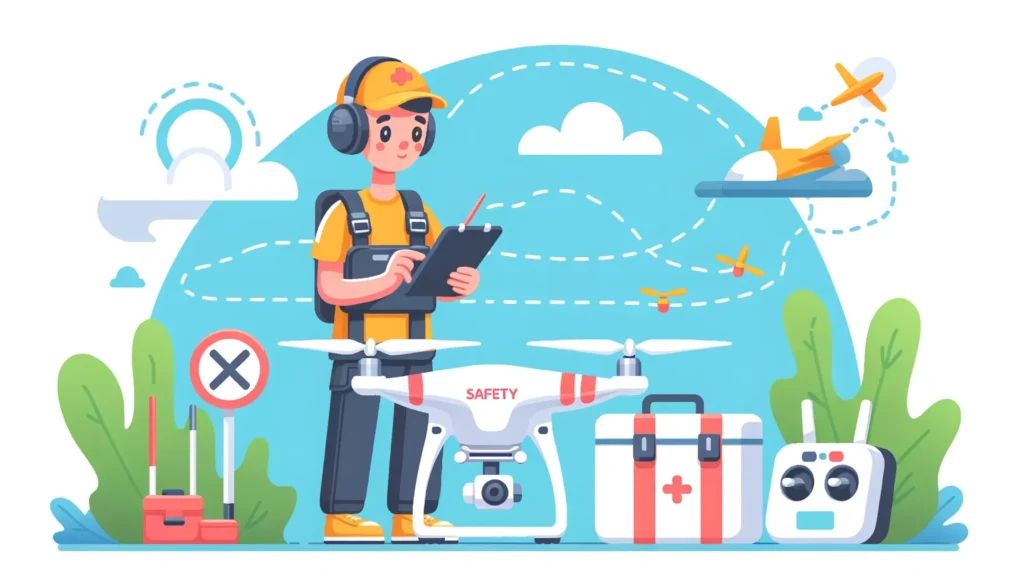Are you an aspiring drone pilot looking to pass the FAA Part 107 Test with flying colors? Look no further! In this article, we will discuss the must-know topics to help you ace the exam and provide valuable insights into utilizing a Free Part 107 Study Guide. Prepare to launch your drone career with confidence and expertise by learning everything from what Part 107 is, why you need certification, and how to find the best study resources.
Key Takeaways
- Understanding Part 107: Learn the FAA rules for commercial drone use.
- Part 107 Certification: Necessary for commercial drone pilots in the U.S.
- FAA Part 107 Exam Topics: Covers airspace, weather, drone loading, emergency procedures, and more.
- Exam Format: 60 multiple-choice questions with a two-hour limit.
- Study Topics: Focus on airspace classification, flight restrictions, weather impacts, drone maintenance, and emergency procedures.
- Test Preparation Resources: Utilize study guides, practice tests, and online courses.
- Exam Strategy: Develop a study schedule, join study groups, and practice with sample questions.
- Practical Examples: Familiarize with example questions for better understanding.

Understanding Part 107
What is Part 107?
Part 107 is a set of rules and regulations established by the Federal Aviation Administration (FAA) for the commercial use of small unmanned aircraft systems (sUAS) or drones weighing less than 55 pounds. It is also known as the Small UAS Rule. This regulation allows drone pilots to operate commercially, opening up various opportunities in industries such as photography, agriculture, and real estate.
Why do I need a Part 107 certification?
Obtaining a Part 107 certification is essential for anyone looking to use a drone for commercial purposes in the United States. The certification demonstrates that you have the knowledge and skills required to operate a drone safely and responsibly in accordance with FAA regulations. Failing to obtain a Part 107 certification can result in fines, penalties, and legal consequences for unauthorized commercial drone operations.
Overview of the FAA Part 107 Test
What topics are covered in the Part 107 exam?
The FAA Part 107 exam evaluates your understanding of various topics crucial for safe and responsible drone operations. Here is a breakdown of the main areas covered in the test:
| Topic | Percentage of Exam Questions |
|---|---|
| Airspace and Requirements | 15-25% |
| Flight Restrictions | 8-15% |
| Aviation Weather Sources | 11-16% |
| Effects of Weather on sUAS Performance | 7-11% |
| Small Unmanned Aircraft Loading | 7-11% |
| Emergency Procedures | 7-11% |
| Crew Resource Management | 7-11% |
| Radio Communication Procedures | 7-11% |
| Determining Performance of sUAS | 7-11% |
| Physiological Factors Affecting Pilot Performance | 5-9% |
| Aeronautical Decision-Making and Judgment | 5-9% |
| Airport Operations | 5-9% |
How many questions are on the Part 107 exam?
The FAA Part 107 exam consists of 60 multiple-choice questions, with a time limit of two hours to complete the test. Each question has three answer choices, and you must score at least 70% (42 correct answers) to pass the exam. The questions are randomly selected from a larger pool, so no two exams are exactly the same.

Must-Know Topics for the FAA Part 107 Test
Airspace Classification
Understanding airspace classification is crucial for safe drone operations. The FAA categorizes airspace into six classes: A, B, C, D, E, and G. Each class has its own set of rules and requirements regarding drone operations, such as altitude restrictions, communication procedures, and equipment requirements.
Flight Restrictions and Regulations
Knowing flight restrictions and regulations is essential for legal and responsible drone usage. Some restrictions include flying below 400 feet, maintaining a line of sight with your drone, not flying over people or moving vehicles, and avoiding operation in restricted areas like airports, national parks, and military installations.
Weather and Micrometeorology
Weather plays a significant role in drone operations. Understanding meteorological concepts like air pressure, temperature, humidity, and wind can help you anticipate and prepare for the effects of weather on your drone’s performance. The FAA Part 107 exam tests your ability to interpret weather reports and forecasts, as well as your knowledge of weather-related risks, such as turbulence, icing, and thunderstorms.
Drone Maintenance and Inspection
Proper drone maintenance and inspection are essential for ensuring safe and efficient operation. The FAA Part 107 exam covers topics like preflight inspections, battery management, and maintenance procedures. Familiarizing yourself with the drone’s components and understanding how to identify and address potential issues is vital for passing the test and operating your drone safely.
Emergency Procedures and Safety Protocols
Emergency situations can arise during drone operations, and understanding how to handle them is crucial. The FAA Part 107 exam covers emergency procedures, such as loss of control, flyaways, and system failures. You’ll need to know how to assess and respond to various emergency scenarios, as well as how to implement safety protocols to minimize risks during flight.
Resources for Effective Test Preparation
Free Part 107 Study Guide and FAA Part 107 Study Guide PDF
A comprehensive study guide is an invaluable resource for preparing for the FAA Part 107 exam. Many free study guides, like the Free Part 107 Study Guide, are available online, offering a thorough overview of the topics covered in the test. Some resources also provide downloadable PDF versions for offline studying, making it easier to review the material at your convenience.
Part 107 Practice Test and Sample Questions
Practicing with sample questions and quizzes is a great way to assess your understanding of the material and identify areas for improvement. Many resources offer free Part 107 practice tests and sample questions to help familiarize you with the exam format and the types of questions you’ll encounter. Regularly testing your knowledge can help build confidence and ensure you’re well-prepared for the actual exam.
Part 107 Test Questions and Answers
Reviewing Part 107 test questions and their answers can help you understand the FAA’s expectations and the level of detail required for each topic. These resources can offer insights into the specific areas the FAA emphasizes, allowing you to focus your study efforts accordingly.
Part 107 Online Course
Online courses can provide a structured and interactive learning experience, making it easier to grasp complex concepts and retain information. Part 107 online courses often include video lectures, quizzes, and interactive exercises, allowing you to learn at your own pace and on your own schedule. Many courses also offer instructor support, giving you access to expert guidance and assistance when needed.
Part 107 Test Prep
Dedicated test preparation resources can help you develop effective study strategies and familiarize yourself with the exam format. Part 107 test prep materials often include comprehensive study guides, practice tests, and tips for acing the exam. Utilizing these resources can help you approach the test with confidence and ensure you’re well-equipped to pass.
Tips for Acing the FAA Part 107 Test
Develop a Study Schedule
Creating a consistent study schedule is crucial for retaining information and ensuring you’re well-prepared for the exam. Dedicate a specific amount of time each day or week to reviewing the material, and break down the topics into manageable sections. Having a structured approach to studying can help keep you on track and motivated throughout the preparation process.
Practice with Sample Questions and Quizzes
Reinforce your understanding of the material by regularly practicing with sample questions and quizzes. This will help you become familiar with the exam format, the types of questions asked, and the level of detail required for each topic. It’s also an excellent way to identify areas where you need to focus your study efforts and improve your overall test-taking skills.
Join Online Study Groups
Connecting with others who are preparing for the FAA Part 107 exam can provide additional support and motivation during your study journey. Online study groups and forums allow you to ask questions, share resources, and exchange tips with fellow aspiring drone pilots. Engaging in discussions and collaborating with others can help deepen your understanding of the material and provide valuable insights that might not be evident when studying alone.
How to Pass the Part 107 Exam
When it comes to passing the FAA Part 107 exam, a combination of diligent preparation, effective study techniques, and a solid understanding of the essential topics is key. Utilize the resources available to you, such as study guides, practice tests, and online courses, and actively apply the knowledge you gain during your study sessions. Remember to approach the test with confidence, and trust in your ability to succeed.

Example Part 107 Test Questions
As you prepare for your FAA Part 107 exam to become a certified remote pilot, it’s essential to familiarize yourself with the types of questions you might encounter during the test. This section will provide you with a variety of example questions to help you gauge your understanding of the material and refine your test-taking strategies. Keep in mind that the actual exam questions may differ, so be sure to study the complete range of topics covered in the FAA’s Part 107 knowledge test.
Airspace Classification
Example Question
Which of the following types of airspace requires authorization for drone operations?
- Class G
- Class E
- Class B
Answer Explanation
Class B airspace requires authorization for drone operations. Class G is uncontrolled airspace, and Class E is controlled airspace but does not always require authorization.
Aeronautical Charts
Example Question
On a sectional aeronautical chart, what does a blue dashed line represent?
- Controlled airspace
- Uncontrolled airspace
- Temporary flight restrictions
Answer Explanation
A blue dashed line on a sectional aeronautical chart represents controlled airspace.
METAR Reports
Example Question
What does the abbreviation “BKN” in a METAR report signify?
- Broken cloud coverage
- Visibility below 1/2 statute mile
- Thunderstorms
Answer Explanation
“BKN” in a METAR report stands for broken cloud coverage.
Loading and Performance
Example Question
What is the effect of a heavier payload on a drone’s flight performance?
- Increased stability
- Decreased maneuverability
- Greater efficiency
Answer Explanation
A heavier payload on a drone results in decreased maneuverability.
Emergency Procedures
Example Question
In the event of a lost link with the remote control, what should a drone pilot do?
- Immediately land the drone
- Activate the return-to-home (RTH) function
- Fly the drone in a figure-eight pattern until the connection is reestablished
Answer Explanation
A drone pilot should activate the return-to-home (RTH) function in the event of a lost link with the remote control.
Crew Resource Management
Example Question
Which of the following best describes the concept of crew resource management (CRM)?
- The effective use of all available resources to ensure safe and efficient flight operations
- The process of assigning tasks to different crew members during a flight
- The method for calculating the maximum payload capacity of a drone
Answer Explanation
Crew resource management (CRM) is the effective use of all available resources to ensure safe and efficient flight operations.
Drone Maintenance
Example Question
How often should you calibrate your drone’s compass?
- Every flight
- Only when flying in new locations
- After any significant impact or exposure to strong magnetic fields
Answer Explanation
You should calibrate your drone’s compass after any significant impact or exposure to strong magnetic fields.
Air Traffic Control
Example Question
When flying in controlled airspace, who has priority in the event of an emergency?
- Drone operators
- Manned aircraft
- Air traffic controllers
Answer Explanation
Manned aircraft have priority in the event of an emergency when flying in controlled airspace.
Radio Communications
Example Question
What is the proper phraseology for stating your altitude in radio communications?
- “Altitude one-thousand feet”
- “One-thousand feet AGL”
- “One-thousand feet MSL”
Answer Explanation
The proper phraseology for stating your altitude in radio communications is “One-thousand feet MSL.”
Drone Registration
Example Question
Which of the following drones is exempt from FAA registration requirements?
- A drone weighing 056 lbs (255 grams) used for commercial purposes
- A drone weighing 0.51 lbs (230 grams) used for recreational purposes
- A drone weighing 0.49 lbs (220 grams) used for commercial purposes
Answer Explanation
A drone weighing 0.51 lbs (230 grams) used for recreational purposes is exempt from FAA registration requirements. Drones weighing less than 0.55 lbs (250 grams) and used for recreational purposes do not need to be registered.
These example questions should help you familiarize yourself with the types of topics and question formats you can expect on the Part 107 exam. To improve your chances of success, be sure to review the FAA’s study materials, practice with additional sample questions, and consider enrolling in a Part 107 test prep course. Remember, practice makes perfect – good luck with your exam!

In conclusion, the earnings for drone pilots can vary significantly based on various factors, including experience, specialization, and location. Understanding these dynamics can empower aspiring pilots to make informed decisions about their careers and maximize their potential income.
If you’re ready to take your drone piloting career to the next level, consider joining our nationwide pilot network. With zero cost to join, you can start building your business without any financial barriers. Enjoy the freedom of a flexible work schedule that fits your lifestyle, coupled with extensive support and training to help you thrive. Our lucrative revenue share model allows you to earn significantly more compared to traditional pilot networks, while you benefit from cutting-edge technology and a community dedicated to elevating industry standards.
Whether you want to operate part-time or scale into a full-fledged business, our program offers the growth opportunities you need to succeed. Visit our Pilot Network page today to discover how you can enhance your earnings and join a thriving community of professionals in the exciting world of drone piloting.




